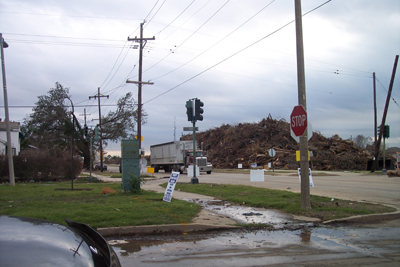
Lakeview District
New Orleans: The City
That America Forgot(continued)
By Lance Cutler
She wants to help get people back, but they are angry. "I tell them not to be angry with New Orleans," she says. "They can be angry with the president, or the mayor or the National Guard, because they are the ones who let us down. They're the ones who refuse to help, but not New Orleans. New Orleans didn't do this to us."
Charmaine struggles to be positive. "Chicago came back after the fire. San Francisco came back after the earthquake. I've got faith in God, and I've got faith in the people of New Orleans. If the government won't help us, then we'll have to do it ourselves, but the point is, New Orleans will be back."
Charmaine Neville is her own force of nature, and she says New Orleans will be back, but is she as strong as Katrina? When you look at the enormity of destruction, when you consider the vastness of the devastation, when you realize that 25 square miles of close-packed houses, schools, businesses, fast-food shops and shopping centers have been completely destroyed, it's difficult to maintain a positive attitude.
At least 70 percent of the city of New Orleans has been destroyed. 1,300 are dead; 350,000 abandoned automobiles filled with mud are slowly being towed to storage yards; 300,000 inhabitants (and if you count the entire Gulf Coast, a staggering 1.3 million) have been displaced to be scattered around to places like Denver and Salt Lake City and Chicago, where it snows, for God's sake.
The city of New Orleans is essential to the health of Louisiana and the entire Gulf Coast. The city's destruction has affected everyone throughout the state of Louisiana. Forty percent of Louisianans had a friend or family member staying in their homes after the storm. Forty percent said they suffered property damage and lost money because they were unable to work. Thirty-one percent of all Louisiana residents lost jobs or were laid off because of the storms. Eleven percent lost their businesses. Thirty-nine percent feel anger. Fifty-three percent are experiencing psychological depression, and who can blame them?
For the people who have returned, those who still have houses, or whose houses are somewhat inhabitable, there's the guilt. They live with the guilt that they have survived where others have not, that they have jobs when others don't, that they got a new refrigerator when others couldn't. They spend their days waiting for insurance adjusters, learning the limits of their flood insurance and the particulars of their homeowner's insurance and the minutiae of their contents insurance.
They wait to move into FEMA trailers so they can rebuild their ravaged homes. They wait for crews to put the temporary blue roofs on their damaged houses. They wait for building materials. They wait days for mail. They wait in long lines to replace their driver's licenses. They wait for food at the restaurants, and they wait on streets choked with traffic, because survivors are all jammed into the remaining Parishes.
All the local news is about the hurricane. Here's who's coming back. Here's who's not. These restaurants are opening. These are closing. Here's the story of the slow return of inhabitants to mid-City. Here are the heart-breaking pictures of people returning to the Ninth Ward for the first time and confronting their loss, finally, three months after the fact. Every single man, woman and child in New Orleans has lived it, and their hearts break all over again. Every one of them has had to drive down the street, not knowing what they would find. Every one of them has had to confront damage, destruction and loss. Every one of them has had to decide whether to stay or to go.
And through it all, through all of the destruction, devastation and
despair, there is the unique wry, sarcastic humor. The ability remains
to look at life's tragedies and turn them into something positive. These
are the people who stare death in the eye and come out dancing. So,
everywhere you look you see things like FEMA trailers decorated with
Christmas lights. Christmas trees decorated with rubber gloves, bleach
bottles, bits of insulation and insurance papers. The Christmas crèche
at the newly reopened Lakeside Mall featured houses with blue roofs
and rescue helicopters pulling people from the homes. For people forced
to live in second-story homes filled with flood water below, they've
created a new lifestyle called "Upstairs Living." At Ralph's
on the Park, you can order a FEMA Cocktail: order it now and we'll get
back to you in two weeks.